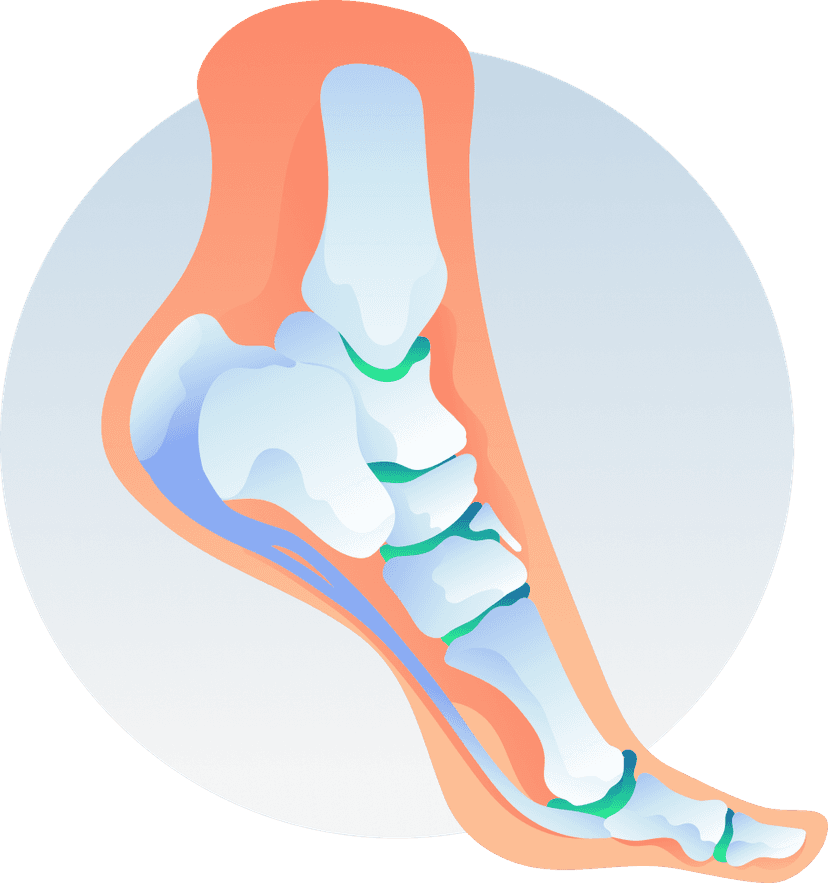
Plantar Fasciitis Symptoms, Causes and Treatment
Plantar fasciitis
Written by
Friðrik Ellert Jónsson
Last updated April 21, 2023
Are you experiencing heel pain when you take your first steps in the morning or after standing or walking for a long time? You might be suffering from plantar fasciitis, a common foot condition affecting millions of people around the world. In this article, we'll explore the symptoms, causes, and treatment of plantar fasciitis.
Jump to
What is plantar fasciitis?
Plantar fasciitis is a condition that causes pain on the bottom of the foot or the heel. It occurs when too much load is placed on the plantar fascia, a thick band of connective tissue that runs from the heel to the toes, resulting in a degenerative process of micro tears.

Plantar fasciitis symptoms
The pain is usually described as a sharp or stabbing sensation that is worst in the morning or after prolonged periods of sitting or standing, but it can also occur after walking or running. The pain is most often felt by the heel but it can also be located further away from the heel towards the toes.

For some, the pain tends to fade during activity and then get worse after stopping. Others might experience it as a dull ache that gradually gets worse during activity. If you experience these symptoms it's most likely due to plantar fasciitis.
What causes plantar fasciitis?
The causes of plantar fasciitis are unclear. The term implies that the condition is caused by inflammation of the plantar fascia. But current research indicates that inflammation is not the primary cause of the condition. Rather, it's thought the condition is caused by too much load on the plantar fascia, resulting in a degenerative process of micro tears and a thickening of the fascia.
Risk factors
There are several factors that can increase your risk of developing plantar fasciitis, including:
- A high body mass index
- A sudden increase in activity, such as walking or running
- Spending a lot of time on your feet
- Tight calf muscles
- Excessive foot pronation
Plantar fasciitis treatment
Fortunately, plantar fasciitis can be managed with conservative treatment for most people. The most effective treatment is a combination of exercises and load management.
Conservative treatment
- Exercises
- Load management
- Taping
- Foot orthoses
- Night splints
- Massage
More invasive treatment
- Shockwave therapy
- Corticosteroid injections
- Surgery
Keep in mind, surgery should always be the last option of treatment and should only be considered after trying every other treatment option.
Exercises for plantar fasciitis
There are several exercises you can do to alleviate pain and improve your overall foot health. The most important exercises are stretches, strength and release exercises for the plantar fascia, calf muscles and other muscles of the foot. If you're looking for specific exercises to alleviate your pain, I've written an article that covers the 7 most important exercises for plantar fasciitis, I recommend you check it out.
It's important to note that doing the exercises a few times will most likely not lead to any measurable results. You have to stay consistent and do them for weeks or even months to see significant improvement, as rehabilitation from plantar fasciitis most often takes 3 to 6 months. If you're ready to start a personalized rehabilitation program for plantar fasciitis, download the Euneo app today to get started.
Get started for free
Start your rehabilitation journey with the Euneo app today. Get started for free with our 7-day trial.
How long is it going to take to get better?
Most people will experience relief or complete resolution of symptoms within 3 to 6 months of rehabilitation. It's common to see an immediate decrease in pain when starting the program, but it might take longer for some. If you still experience pain or limitations after completing the program I recommend that you consult with your healthcare provider.
Long term complications of plantar fasciitis
When dealing with plantar fasciitis it's essential to listen to your body. Ignoring the warning signs can cause the condition to become chronic, which can ultimately limit your physical activity, decreasing your health and quality of life. You're also likely to change the way you walk to avoid pain, which can lead to foot, knee, hip, or back problems. That's why it's essential to take the required measures to manage it as soon as you can.
Hundreds of success stories
Empowering hundreds of people all over the world to take an active role in their recovery.
When I started I was unable to participate in sports without significant foot pain afterwards. Now I'm back doing my usual activities with minimal discomfort.

Gene Shannon
Canada
I've been dealing with Plantar fasciitis pain for so long and have tried everything. After four weeks of the program the pain is almost completely gone. I even started hiking again!

Eliza Ching
United States
Checking off the exercises and getting notified makes it so easy to stay accountable. I made tremendous progress and was back to training in just a couple of weeks.

Patrik Gunnarsson
United Kingdom
Articles
Our programs and articles are made by medical professionals and are based on decades of clinical experience and research.


7 Plantar Fasciitis Exercises That Relieve Pain
Plantar fasciitis is a common foot condition that can cause a great deal of discomfort and pain, particularly when walking or standing for long periods of time. Fortunately, there are several exercises you can do to alleviate this pain and improve your overall foot health. In this article, I'll share with you seven effective plantar fasciitis exercises that you can do at home.
Read more

Plantar Fasciitis Taping: Complete Guide
Taping can be a game changer for Plantar fasciitis. If done right, it can provide immediate pain relief and make your life a lot easier. However, not all taping techniques are created equal. In this article, I'm going to cover everything you need to know about taping and how to use it effectively.
Read more
